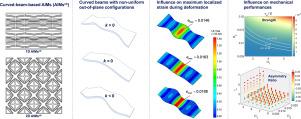Behavior of architected instability-based metamaterials (AIMs) under out-of-plane geometric variations
IF 3.8
3区 工程技术
Q1 MECHANICS
International Journal of Solids and Structures
Pub Date : 2025-10-06
DOI:10.1016/j.ijsolstr.2025.113682
引用次数: 0
Abstract
Architected instability-based metamaterials (AIMs), composed of multistable elementary building blocks, can undergo highly reversible geometric phase transformations, making them ideal for dynamic systems such as energy-dissipating structures and micro-electro-mechanical devices (MEMS). While prior research has largely focused on in-plane geometries and global responses, limited studies have explored how out-of-plane geometry affects the critical mechanical behavior of AIMs. Here, we study a representative class of AIMs constructed from curved beam-based building blocks, , and investigate how their out-of-plane geometry influences key performance metrics. rely on elastic buckling of slender beams to achieve reversibility, which limits their strength and energy dissipation. Their limited geometric tunability also constrained their utility in MEMS requiring diverse multistable behaviors. To address these limitations, we introduce a new geometric control parameter, , to adjust the out-of-plane geometry of and tune their mechanical properties. Our results show that governs the localization of maximum strain, thereby controlling the reversibility and robustness of the multistable response. Using finite element simulations, digital image correlation, and cyclic compression experiments, we demonstrate that with achieve up to 62.1% higher compressive strength and 45.6% greater energy dissipation, while also enabling a broader range of tunable multistable behaviors. The simplicity of fabricating out-of-plane geometries further enhances the practical applicability of , extending their use from energy-focused applications such as packaging, shock absorption, and impact protection to adaptive systems including MEMS and other multistability-driven devices.

面外几何变化下基于体系结构不稳定的超材料(AIMs)的行为
基于体系结构不稳定性的超材料(AIMs),由多稳定的基本构件组成,可以经历高度可逆的几何相变,使其成为动态系统的理想选择,如能量耗散结构和微机电设备(MEMS)。虽然之前的研究主要集中在面内几何形状和整体响应上,但很少有研究探讨面外几何形状如何影响AIMs的关键力学行为。在这里,我们研究了一类由基于弯曲梁的构建块(AIMscb)构建的具有代表性的AIMs,并研究了它们的面外几何形状如何影响关键性能指标。AIMscb依靠细长梁的弹性屈曲来实现可逆性,这限制了细长梁的强度和能量耗散。它们有限的几何可调性也限制了它们在需要多种多稳态行为的MEMS中的应用。为了解决这些限制,我们引入了一个新的几何控制参数k来调整AIMscb的面外几何形状并调整其力学性能。结果表明,k控制最大应变的局部化,从而控制多稳态响应的可逆性和鲁棒性。通过有限元模拟、数字图像相关和循环压缩实验,我们证明了k>;0的AIMscb可以实现高达62.1%的抗压强度和45.6%的能量耗散,同时还可以实现更大范围的可调多稳态行为。制造面外几何形状的简单性进一步增强了AIMscb的实用性,将其应用范围从封装、减震和冲击保护等以能量为中心的应用扩展到自适应系统,包括MEMS和其他多稳定性驱动的设备。
本文章由计算机程序翻译,如有差异,请以英文原文为准。
求助全文
约1分钟内获得全文
求助全文
来源期刊
CiteScore
6.70
自引率
8.30%
发文量
405
审稿时长
70 days
期刊介绍:
The International Journal of Solids and Structures has as its objective the publication and dissemination of original research in Mechanics of Solids and Structures as a field of Applied Science and Engineering. It fosters thus the exchange of ideas among workers in different parts of the world and also among workers who emphasize different aspects of the foundations and applications of the field.
Standing as it does at the cross-roads of Materials Science, Life Sciences, Mathematics, Physics and Engineering Design, the Mechanics of Solids and Structures is experiencing considerable growth as a result of recent technological advances. The Journal, by providing an international medium of communication, is encouraging this growth and is encompassing all aspects of the field from the more classical problems of structural analysis to mechanics of solids continually interacting with other media and including fracture, flow, wave propagation, heat transfer, thermal effects in solids, optimum design methods, model analysis, structural topology and numerical techniques. Interest extends to both inorganic and organic solids and structures.

 求助内容:
求助内容: 应助结果提醒方式:
应助结果提醒方式:


